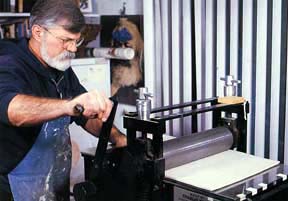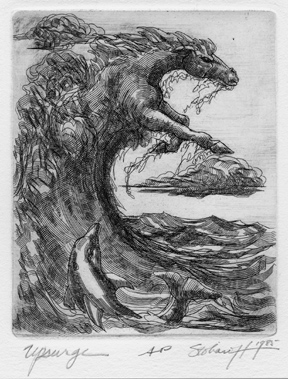
(845) 246-6944 · info@ArtTimesJournal.com
Prints
vs. Reproductions
By PHIL
METZGER
ART TIMES Jan/Feb, 2005
Question:
When is a print not a print?
Answer: When it’s a reproduction.
|
|
Like a lot
of words in the English language, “print” and “reproduction”
are often misused, sometimes by accident, sometimes on purpose. Both prints
and reproductions are copies of some original image, but they are
made in quite different ways. Prints are copies painstakingly made by
the artist, one at a time; reproductions are copies made mechanically,
usually quickly and in large numbers, without involving the artist. Because
the term “print” has been watered down and made ambiguous,
some prefer the term original print to more firmly signal the participation
of the artist in its production.
Prints
are made in a number of ways: Relief prints (e.g., woodcuts, linocuts)
are made by carving away unneeded areas from the surface of a material,
inking the remaining areas and pressing paper against the inked surface.
Intaglio prints (e.g., etchings, engravings, drypoints) are made
by forming grooves in a surface, forcing ink into the grooves, wiping
the rest clean and pressing paper against the surface so that the paper
picks up ink from the grooves. Surface, or planographic,
prints (e.g., lithographs, monotypes) are made by forming an image on
a completely flat surface and transferring that image to a piece of paper. Stencil prints (e.g., serigraphs) are
made by forcing ink or paint through unprotected areas of a guide, or
stencil, onto a sheet of paper, fabric, or other material.
Reproductions
have long been made by the process of offset lithography using large,
expensive printing presses to make copies rapidly and in large numbers
without directly involving the artist. These days, some artists are making
copies on ordinary office copy machines—since the artist may run
the machine to make the copies, it may sound as if that qualifies these
copies as prints, but let’s not stretch things that far! A more
recent way of making copies is the giclée process using a computer
and a special inkjet printer. Giclée copies are most often advertised
as prints, but they are in fact reproductions (admittedly high-quality
reproductions). Sooner or later artists will operate their own computer-printer
setups and personally introduce variations from one copy of an image to
the next that may qualify these copies as prints — stay tuned.
Prints are made in limited editions — that is, there are a fixed number of images made and no more. If, say, fifty copies of a particular image are made, the edition size is 50. Usually the artist signs and numbers each copy 1/50, 2/50 and so on, traditionally in pencil, which helps signal that the signing and numbering were not done by mechanical means. Signing and numbering each copy gives the buyer some assurance that the artist has personally viewed and approved each one. It’s become widespread practice to sign and number reproductions in the same way — in that case, signing does not imply that the artist actually had a hand in producing the copy, but only that he or she did look at each copy and that the number of copies to be sold is limited to the stated edition size. The term “open edition” means there is no limit to the number of copies that will be produced; in this case numbering the copies would be meaningless.
|
|
Despite the significant differences between prints and
reproductions, “print” has become the word of choice for any
copy and these days you’ll find many people at art fairs selling
“prints” that are really reproductions. Why?
1.
Prints sell better. “Reproduction” has a cheap connotation
and, given a choice, a buyer will almost always choose a print over a
reproduction. Much of the buying public doesn’t know the difference
between the two. If you label your reproductions
“reproductions” and the guy in the next booth labels
his reproductions “prints” — other things being equal
— which of you do you think will attract more buyers?
2. Ignorance. Not only does the public not
know the difference between a print and a reproduction, but neither do
many so-called artists. In my painting classes I talk about this, hoping
to do a little to inform the next generation of artists, but it’s
a tough battle. People simply prefer to say print!
Which leads me to the next point:
3. Print rolls off the tongue more easily
than reproduction. Why use
a four-syllable word when you can use a one-syllable word? Sorry to say, I catch myself occasionally
swapping the simple “print” for the formidable “reproduction”
in casual conversation.
4. In photography, print is the accepted
word for any number of copies of an image and it’s easy to understand
the carryover from photography to printmaking.
Our
language is rich and constantly evolving and, as Martha Stewart might
say, that’s a good thing. But I think there’s a big difference
between decent evolution and plain dumbing-down. Just because most television
commentators say “lay” when they mean “lie” and
“these kind” when they mean “this kind” doesn’t
mean we have to alter our language to accommodate them. Art should be
a place where quality and honesty still count for something, so please,
let’s at least get our terms right.
(Phil
Metzger, artist, teacher, and author of several art books, lives in Rockville,
MD. You’ll find much more on printmaking and specific kinds of prints
in his book, The Artist’s Encyclopedia, available from North
Light Books, at 1-800-289-0963.)
 Maryland
printmaker Peter Stoliaroff at his Charles Brand etching press.
The same press can be used for pulling other forms of prints, including
engravings, drypoints and embossings. (Photo permission of Peter
Stoliaroff)
Maryland
printmaker Peter Stoliaroff at his Charles Brand etching press.
The same press can be used for pulling other forms of prints, including
engravings, drypoints and embossings. (Photo permission of Peter
Stoliaroff)  Line
etching "Upsurge" by Peter Stoliaroff, 4 1/4" x 4".
Permission of Peter Stoliaroff, whose work may be seen in Phil Metzgeršs
book, The Artistšs Illustrated Encyclopedia, North Light Books,
Cincinnati, 2001
Line
etching "Upsurge" by Peter Stoliaroff, 4 1/4" x 4".
Permission of Peter Stoliaroff, whose work may be seen in Phil Metzgeršs
book, The Artistšs Illustrated Encyclopedia, North Light Books,
Cincinnati, 2001